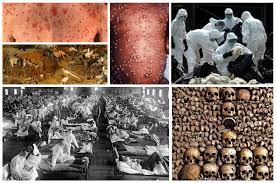
Throughout human history, there have been outbreaks of diseases that have affected an immense number of people in many regions of the world. If we go back into remote times we will have less precision about diseases and their consequences. But humanity has always had to face Pandemics that have caused millions of deaths.
Plague of Justinian
It occurred between the years 541-542 and is estimated that it caused between 30 and 50 million deaths, making it the fourth-worst Pandemic in history.
The outbreak had its epicenter in Constantinople – currently Istanbul -, capital of the Byzantine Empire (Eastern Roman Empire). The origin of this disease was derived from rats arriving on merchant ships from different corners of Eurasia, carriers of fleas infected with bubonic plague.
Emperor Justinian I also contracted the disease, but he survived.
The Black Death
It took place between the years 1347 and 1351 with an estimate of 200 million deaths.
It is considered the deadliest Pandemic in human history and with the longest lasting impact of all time. The outbreak is believed to have started in Central Asia, and from there it passed through the Silk Road to the Crimean Peninsula – disputed between Russia and Ukraine today – in 1343.
Housed in the fleas of black rats, it spread throughout Europe using merchant ships as a means of transport.
Smallpox
This pandemic occurred in the year 1520 and caused 56 million deaths.It currently represents the second largest Pandemic in history, and estimates indicate that it killed up to 90% of the Native American population.
Cholera
The Cholera outbreak occured in the 17th century with a death toll of around 3 million.During this century there were different outbreaks of cholera in various epicenters. One of the most significant was in the city of London, which lasted from 1665 to 1666, being the last great epidemic in England.
The main cause of this disease was the lack of proper disposal of human excrement and the absence of suitable drinking water.
The third Asian bubonic plague
The third Asian bubonic plague pandemic emerged in Yunnan, China, during the fifth year of Emperor Xianfeng of the Qing dynasty. From there it spread throughout the world, although nowhere did it have such a deadly impact as that of India, where it caused nearly 10 million deaths. It is the sixth deadliest pandemic in history.
The Spanish flu
It appeared between 1918 and 1919, with a number of deaths ranging from 40 to 50 million people.Known as the first pandemic caused by the influenza virus, H1N1, it became the third deadliest in human history.
It is estimated that it infected 500 million people worldwide, 27% of the global population.
HIV AIDS
Its first cases appeared in 1981 and to date have caused between 25 and 35 million deaths.It is caused by a human immunodeficiency virus that originated from primates in central and western Africa in the early 1900s.
COVID-19
The COVID-19 pandemic has unleashed a serious global crisis that has not been seen in humans for a long time. The first cases appeared in December 2019, in Wuhan, China, and to date there have been more than 2.8 million infected with more than 205,000 deaths worldwide.
We have seen how the strongest Pandemics that have appeared in the world have caused millions of deaths. Today we face the COVID-19 Pandemic, and it is up to us to prevent it from ending so many lives around the world. Prevention, our greatest tool!
We believe in the New Earth Shift towards a sustainable lifestyle that creates our own resources and is moving towards self-governance between the people. This will enable people to have more time for themselves and their practice as well as taking care of the planet and learn the traditional ways that once lead the land.
http://ResonanceCR.com/
